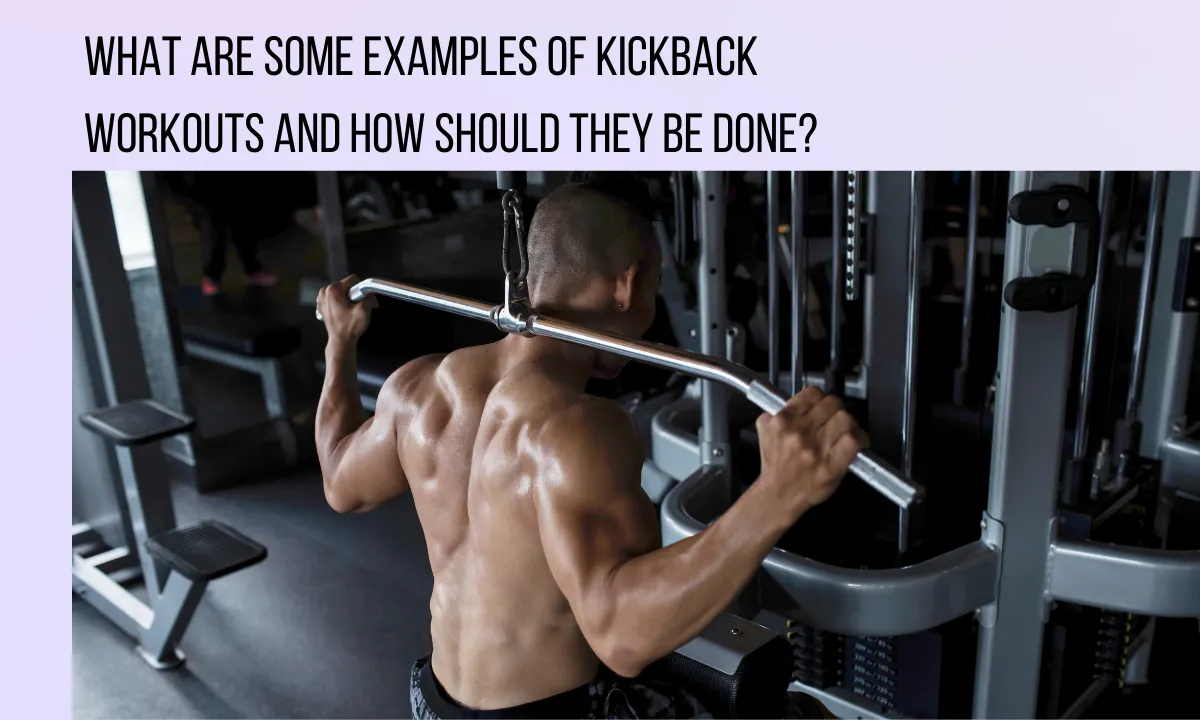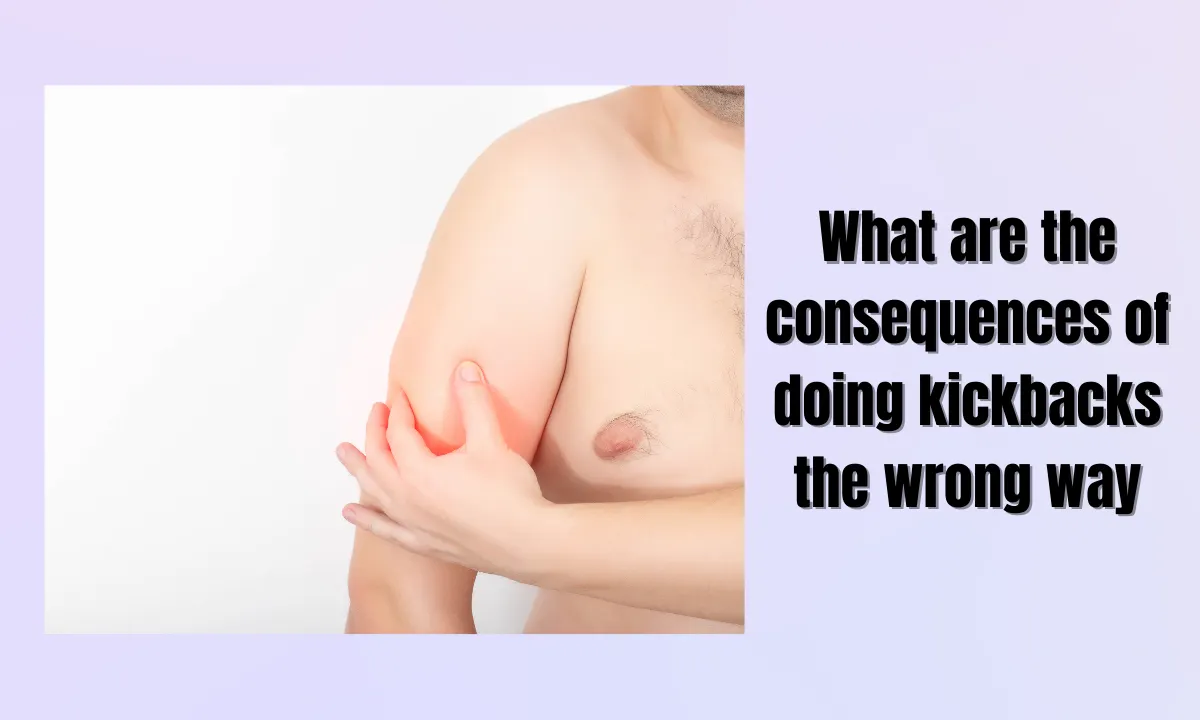Table of Contents
There are a lot of exercises you can do to work the posterior shoulder. These muscles support and rotate your arm, so if your shoulders are a weak point for you, it may be beneficial to include exercises specifically meant to strengthen them. In this article, we’ll discuss what kickback workouts are and provide examples of different types of exercises that focus on the posterior shoulder, and others. We’ll also talk about the consequences of doing them incorrectly.
What are kickback workouts?
Kickback workouts are exercises that primarily involve the posterior shoulder. They work the muscles on the upper back and outer portion of your shoulders, like your trapezius, infraspinatus, and teres minor. Since they primarily target the back of your shoulders, many people call them “posterior deltoid” workouts instead of “shoulder workouts.”
Kickback workouts are commonly done by athletes who play sports that involve a lot of arm and shoulder rotation, like baseball or tennis. Kickbacks are also done by bodybuilders. They’re sometimes done before an arm workout to warm up the shoulders, or on their own day as a specific shoulder workout.
Generally, kickback workouts are done using machines, cables, and free weights. However, there are variations you can do like high incline dumbbell kickbacks, decline dumbbell kickbacks, and cable reverse flyes that don’t require any equipment.
What are the benefits of doing kickback workouts?
There are a lot of benefits to doing kickbacks, depending on which exercises are being done. It will help you develop strong shoulders, specifically the upper portion of your deltoids, which is an important muscle for athletics. If you play a lot of sports or want to work on your posture, this should be beneficial to improving both things.
Cable kickbacks are very effective at targeting the posterior shoulder muscles. This can help improve strength and muscle tone in your shoulders. In fact, studies have shown that the posterior shoulder is generally “underdeveloped” compared to the rest of your body.
There are also a lot of variations you can do for kickbacks, so if you get bored with doing the same thing over and over again, switch it up and try something else.
Another benefit of kickback exercises is that it clenbuterol dosage for weight loss is relatively easy on the shoulders compared to other exercises. This makes it easier to do with less risk of injury or discomfort.
Kickback exercises also work other muscles in the shoulder, so you’ll see benefits to things like your posture and stability.
See also The 12 All-Time Greatest Female Weightlifters
What are some examples of kickback workouts and how should they be done?
Cable Kickbacks
Cable kickbacks are done using a low pulley and performing a reverse fly movement. It works the medial deltoid, infraspinatus, posterior deltoid, and middle trapezius.
- To do this workout:
Stand and face away from the low pulley machine with feet shoulder-width apart or closer for stability. Grasp the handle with your feet together. It’s better to have a lighter weight for this exercise, so if you feel the need to increase the weight, it’s best to use resistance bands instead of a cable.
With your back straight and head up, pull your arms back until they are at shoulder height or slightly higher. Pause for a second before slowly returning to the starting position.
Try to use as much of your rear deltoid as possible, and squeeze at the top for a second before lowering back down.
Doing this will activate all your shoulder muscles, which will help strengthen your shoulders and back. This is a very effective workout for targeting the middle portion of your trapezius, posterior deltoid, infraspinatus, and teres minor.
Cable Kickbacks are good for people who play a lot of sports or want to improve their posture.
You don’t need any special equipment for this workout.
Try using 10-20lbs for resistance, and do 3 sets of 12-15 reps. Switch sides halfway through the workout if you’re doing both arms at once. Don’t use too much weight, because it can cause injury.
See also Battle Rope, Jump Rope, and Other Rope Workouts
Cross-Body Kickbacks
Cross-Body Kickbacks are done by using both arms at once, instead of just one. This works the posterior deltoid and infraspinatus much more than regular Cable Kickbacks.
- To do this workout:
Stand or sit with your back straight, feet shoulder-width apart for stability. Hold a dumbbell in each hand, palms facing forward. Keep your elbows bent and palms facing down throughout the exercise.
Keeping your back straight and head up, lift the weights out to either side of your body until they’re shoulder height or slightly higher. Pause at the top for a second before slowly returning to the starting position.
Doing this workout activates all four muscles in your shoulders, including your posterior deltoid, middle trapezius, infraspinatus, and teres minor.
This is a great workout for improving your posture by working the muscles in your shoulders that give you good sitting alignment. It’s also beneficial for athletes because it will improve their strength and speed while protecting their shoulders from injury.
You don’t need any special equipment for this workout.
Try using 10-20lbs of resistance, and do 3 sets of 12-15 reps. Switch sides halfway through the workout if you’re doing both arms at once. Don’t use too much weight, because it can cause injury.
Cable Reverse Kickbacks
Cable Reverse Kickbacks is an exercise that can be done using a cable or resistance band, and it mainly works the posterior deltoid.
- To do this workout:
Sit with back straight or stand with feet shoulder-width apart for stability. Grasp the handle of your chosen form of resistance with both hands, palms facing each other as if you’re about to pray.
With your arms slightly bent, pull the handle up and to the outside of your right hip. Pause at the top before returning slowly to the starting position. Make sure your arms are pulling straight up, not to the sides.
This targets all four muscles in your shoulders (posterior deltoid, middle trapezius, infraspinatus, teres minor), and it’s also good for improving your overall posture. Whenever you’re sitting at a computer or driving long distances, this workout will keep your shoulders strong and pain-free.
You don’t need any special equipment for this workout. Try using 10-20lbs of resistance, and do 3 sets of 12-15 reps. Switch sides halfway through the workout if you’re doing both arms at once. Don’t use too much weight, because it can cause injury.
If you have any shoulder problems, just do Cable Kickbacks most of the time. We recommend doing 3 sets of 12-15 reps because more weight can cause injury if you’re not used to it.
See also The Best Workout Routine Ever for Natural Lifters
Lying Cable Reverse Kickbacks
Lying Cable Reverse Kickbacks can be done using a cable or resistance band, and it mainly works the posterior deltoid.
- To do this workout:
Lie face-up on a bench (or an exercise ball) with your legs straight and feet firmly planted on the ground. Grasp the handle of your chosen form of resistance with both hands, palms facing each other as if you’re about to pray.
With your arms slightly bent, pull the handle up and to the outside of your right hip. Pause at the top before returning slowly to the starting position. Make sure your arms are pulling straight up, not to the sides.
This targets all four muscles in your shoulders (posterior deltoid, middle trapezius, infraspinatus, teres minor), and it’s also good for improving your overall posture. Whenever you’re sitting at a computer or driving long distances, this workout will keep your shoulders strong and pain-free.
You don’t need any special equipment for this workout. Try using 10-20lbs of resistance, and do 3 sets of 12-15 reps. Switch sides halfway through the workout if you’re doing both arms at once. Don’t use too much weight, because it can cause injury.
If you have any shoulder problems, just do Cable Reverse Kickbacks most of the time. We recommend doing 3 sets of 12-15 reps because more weight can cause injury if you’re not used to it.
We know sometimes the exercises might be a little confusing so we’ve made this quick video to show you how it’s done.
These exercises are great for toning your shoulders, but it doesn’t do much if you don’t know what kind of foods to eat.
Decline Dumbbell Kickbacks
Decline Dumbbell Kickbacks is an exercise that can be done using dumbbells, and it mainly works the posterior deltoid. This is done by bending forward and simultaneously raising one leg and the opposite arm toward your side. This exercise is generally done by athletes and bodybuilders.
- To do this workout:
Stand with your feet shoulder-width apart and hold the dumbbells at arm’s length in front of your waist with palms facing behind you. Bend forward about 20 degrees from the hips. Keep your back straight and core engaged to prevent you from tilting too far forward (which can cause injury).
Raise one dumbbell forward and up to shoulder height, then quickly raise your opposite arm behind you. Lower the weight back down in front of you before repeating with the other arm. Make sure your head stays in line with your spine throughout this movement; don’t look up at the weights or lean back excessively (which can cause injury).
This can be a great way to tone your shoulders and improve your posture, but it’s only effective if you get the proper nutrition.
High Incline Dumbbell Kickback
High Incline Dumbbell Kickbacks are great for athletes and bodybuilders who are looking to tone their shoulders, and it mainly works the posterior deltoid. It is done by lifting one dumbbell up in front of you while simultaneously lifting your opposite leg towards your chest, then returning them back down to the starting position.
- To do this workout:
Stand on an exercise ball with feet shoulder-width apart, holding a dumbbell in each hand at arm’s length next to your hips with palms facing behind you. Keep your abs engaged for stability throughout the movement, and don’t lock out your knees or allow them to drop toward the floor as you raise the weights backward.
Don’t lean forward during this motion, which can cause injury. Bending only slightly at the hips, bend forward about 20 degrees from the hips. Raise one dumbbell forward and up to shoulder height, then quickly raise your opposite leg toward your chest. Lower the weight back down in front of you before repeating with the other arm.
This workout is great for toning your shoulders, but it isn’t very effective if you don’t have the proper nutrition.
You might also want to know WHAT IS BLOOD FLOW RESTRICTION?
Seated Dumbbell Kickbacks
Seated Dumbbell Kickbacks is an exercise that can be done sitting on a bench, and it mainly works the posterior deltoid. Athletes and bodybuilders use it to tone their shoulders, and it’s done by raising one dumbbell up in front of you while simultaneously lifting your opposite leg toward your chest. Then you slowly return the weight back down to the starting position.
- To do this workout:
Sit on a bench with legs slightly bent, extending them in front of you with feet placed firmly on the floor. Hold a dumbbell in each hand at arm’s length next to your hips with palms facing behind you. Keep your abs engaged for stability throughout this movement, and don’t lock out your knees or allow them to drop toward the floor as you raise the weights backward.
Don’t lean forward during this motion, which can cause injury. Bending only slightly at the hips and keeping your back straight (not rounded), bend forward about 20 degrees from your hips. Raise one dumbbell forward and up to shoulder height, then quickly raise your opposite leg toward your chest. Lower the weight back down in front of you before repeating with the other arm.
This workout is great for toning your shoulders, but it isn’t very effective if you don’t have the proper nutrition.
Seated Alternating Dumbbell Kickbacks
Seated Dumbbell Kickbacks is an exercise that can be done sitting on a bench, and it mainly works the posterior deltoid. Athletes and bodybuilders use it to tone their shoulders, and it’s done by raising one dumbbell up in front of you while simultaneously lifting your opposite leg toward your chest. Then you slowly return the weight back down to the starting position.
- To do this workout:
Sit on a bench with legs slightly bent, extending them in front of you with feet placed firmly on the floor. Hold a dumbbell in each hand at arm’s length next to your hips with palms facing behind you. Keep your abs engaged for stability throughout the movement, and don’t lock out your knees or allow them to drop toward the floor as you raise the weights backward.
Don’t lean forward during this motion, which can cause injury. Bending only slightly at the hips, bend forward about 20 degrees from the hips. Raise one dumbbell forward and up to shoulder height, then quickly raise your opposite leg toward your chest. Lower the weight back down in front of you before repeating with the other arm.
This workout is great for toning your shoulders, but it isn’t very effective if you don’t have the proper nutrition.
What are the consequences of doing kickbacks the wrong way?
It is incredibly important that these exercises are done right because if they’re not, you will risk injuring yourself.
One injury that can be caused by incorrectly doing Kickbacks is a rotator cuff tear. One of the muscles that’s used in this type of exercise is the infraspinatus, which can put a strain on your shoulder joints when you use the bad form or don’t have a full range of motion while using these weights.
Another injury that can come from doing Kickbacks the wrong way is a bicep strain. If you use too much weight in Kickbacks, you can strain your muscles and cause a lot of pain.
Injuries can also come from doing kickbacks without the proper diet and nutrition. The food we eat can highly affect our athletic performance. Failing to do so can lead to some injuries such as rotator cuff tear.
Conclusion and summary
Kickbacks are great exercises for strengthening the muscles in your back, but if they are done wrong or with bad form, they can cause a lot of damage to your body. Always do these exercises correctly and with the proper diet and nutrition to maintain a healthy athletic lifestyle.
You might also want to know WHAT IS DRY NEEDLING?






